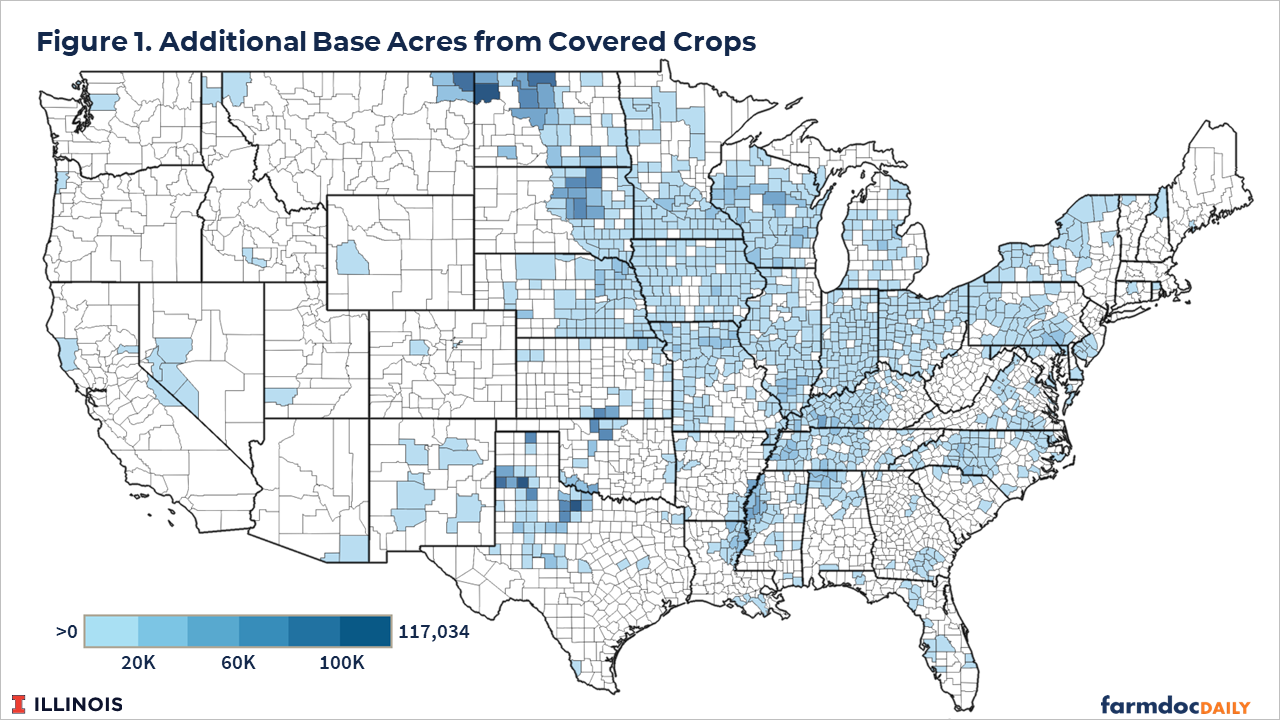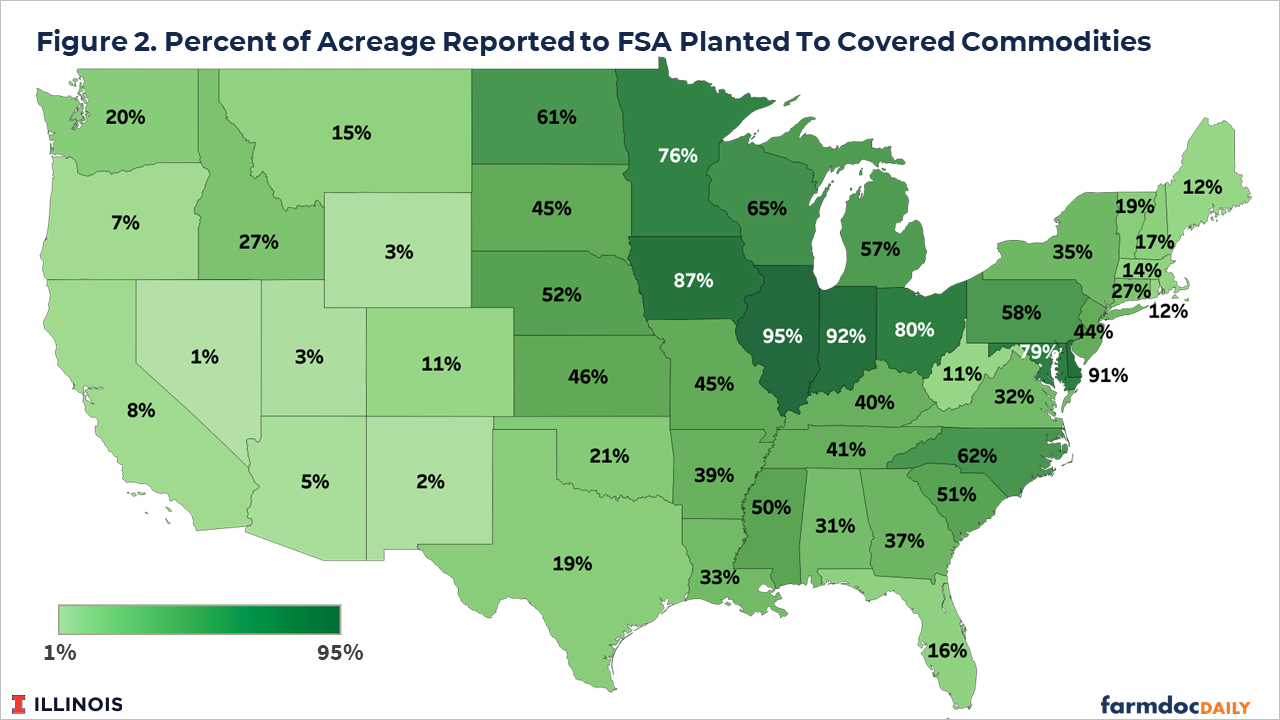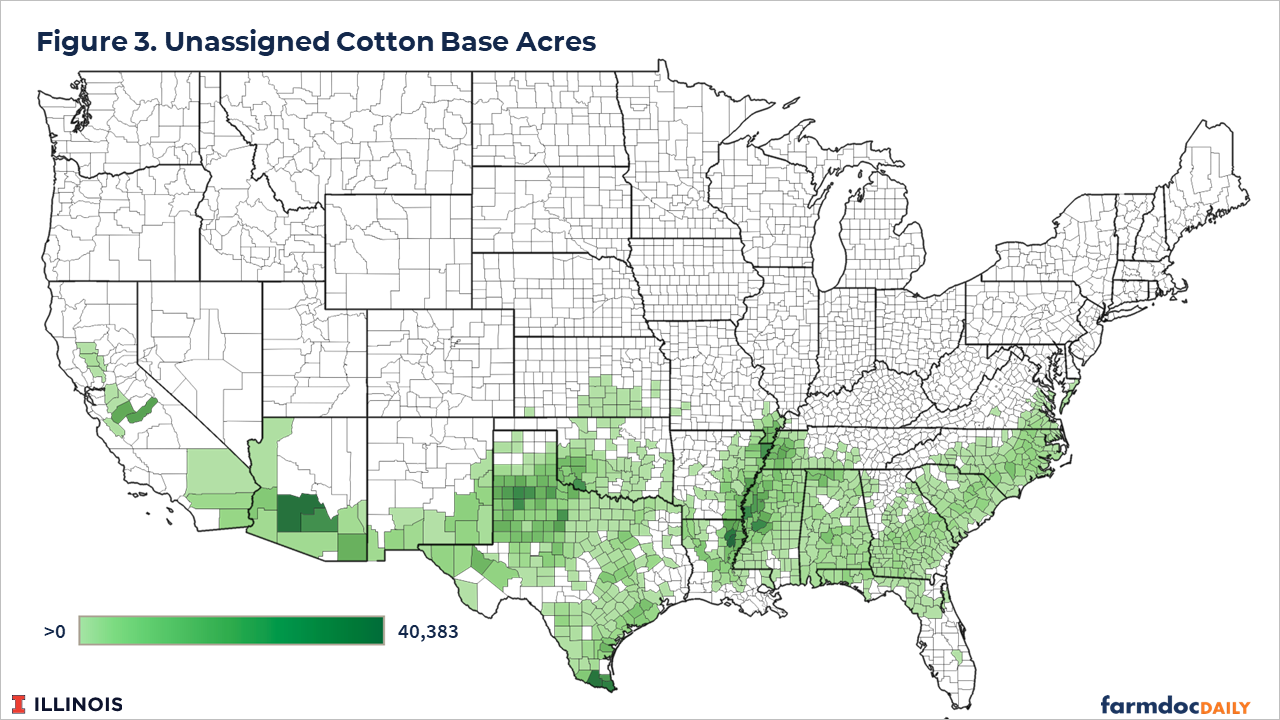Reconciliation Bill Proposals to Add Base Acres
The Reconciliation Bills moving through Congress include proposals that would increase the number of base acres eligible for farm program payments. For farms that planted acreage to eligible crops from 2019 to 2023, base acres could be added to Farm Service Agency (FSA) farms if current base acres are exceeded by the sum of three acreage categories 1) plantings (and prevent plantings) of covered crops from 2019 to 2023, 2) plantings (and prevent plantings) to eligible non-covered crops from 2019 to 2023, plus 3) unassigned cotton base acres. This proposal will add base acres, almost certainly up to the 30 million acre cap imposed in the bills. Moreover, many more farms will have base acres that exceed planted acres, particularly in regions outside the Midwest. In a relative sense, areas with unassigned cotton base have the potential to add the most acres. This proposal will also not align base acres to planted acres, a reasonable objective if the goal is to provide risk protection (farmdoc daily, September 30, 2020; August 10, 2023).
Adding Base Acres
Provisions contained in Reconciliation Bills moving through Congress include proposals to add additional base acres. Base acres are used to make payments for the two commodity title programs: Price Loss Coverage (PLC) and Agriculture Risk Coverage (ARC). Each Farm Service Agency (FSA) farm has base acres that typically remain unchanged from year to year. Base acres are based on historical plantings but can vary significantly from what is currently planted on a farm. Changes in base acres require an act of Congress, typically in a farm bill.
Note that provisions adding base acres would not change existing base acres. Instead, if a farm had any plantings or prevented plantings of covered commodities from 2019 to 2023, the following calculations would be made to determine if base acres can be added to that FSA farm. These calculations compare the sum of three acreage categories to existing base acres. If the sum exceeds current base acres, base acres could be added to a farm.
The acreage categories are:
- Average of covered crops that were planted and prevented from planting from 2019 to 2023. Covered commodities include corn, soybeans, wheat, peanuts, seed cotton, rice, oats, barley, sorghum, and minor oilseeds (a full listing of all 22 covered commodities is available here: https://www.fsa.usda.gov/resources/programs/arc-plc).
- The lesser of 15% of total acres or average plantings of eligible non-program crops from 2019 to 2023. What is an eligible program crop is left to the discretion of the Secretary of Agriculture. The language in the bills explicitly states that the eligible crops will not include covered crops, trees, bushes, vines, grass, or pasture, but will include cropland that is idle or fallow.
- Unassigned generic cotton acres. Unassigned generic acres are left over from when upland cotton was taken out of the program to settle a World Trade Organization (WTO) case with Brazil. Some of those base acres were reassigned as seed cotton base acres in 2018 when seed cotton was included in the program. However, not all of the old upland cotton acres were reassigned when seed cotton was re-enrolled. These leftover acres are the most likely to be added by these provisions if enacted. Both House and Senate versions are somewhat nebulous on how these unassigned base acres are to be handled. We interpreted that they would be included in this calculation. Given the wording of the bills, it is possible that FSA could give a more generous treatment of unassigned base acres than is included in the interpretation here.
The above sum is calculated and then compared to existing base acres. If the sum exceeds base acres, acres will be added to the farm. Existing and added base acres cannot exceed the farm’s total tillable acres.
The additional base acres will be assigned to program crops based on their average percent plantings from 2019 to 2023.
Estimate of Additional Base Acres
In our judgment, the potential number of base acres that could be added will exceed the 30 million acre cap specified in each bill. At that point, FSA will need to determine ways to prorate the added acres. Below we present a discussion of potential additions by acre type:
Covered Crops Planted and Prevented Plant: Farmers report acres planted and prevented plant on all farms enrolled in commodity title programs to the Farm Service Agency (FSA). Annually, FSA reports this data on a county-level basis. We summarized and compared this planting data to existing base acres by county. For each county, we calculated the average of program crops planted from 2019 to 2023. Then, we subtracted the number of base acres in that county.
Many counties had plantings and prevented plantings less than existing base acres. That, however, does not mean that those counties will not add base acres as some individual FSA farms will have plantings that exceed current base acres. For the same reason, additional base acres will be larger in those counties with plantings above base acres. Our county-level estimates should be viewed as conservative estimates of the potential base acre increase that could result from the proposals.
In those counties with positive base acres, the total number of planted and prevented plant acres exceeds existing base acres by more than 10 million acres. Again, this is a lower bound on acres that could be added by covered crop plantings exceeding base acres. Figure 1 shows a distribution of those acres. As can be seen, the potential to add acres is large in:
- Texas (1 million acres).
- Wisconsin (730,000 acres).
- North Dakota (726,000 acres).
- South Dakota (635,000 acres).
- Nebraska (619,000 acres).
Eligible Non-Program Crops: Farms will be able to add base acres from plantings of eligible non-program crops, up to 15% of the farm’s total tillable acres. This value could be large, as there are 320 million acres planted to principal crops in the U.S. Presumably, all principal crops that are not program crops would be eligible. The potential to add acres will be in regions and on farms that have fewer of their tillable acres planted to current program crops. For each state, we calculated the percent of reported acres in program crops compared to all principal crop acres (see Figure 2). Those percentages tend to be highest in Midwest states — 95% in Illinois, 92% in Indiana, 87% in Iowa — where corn and soybean rotations predominate. Less potential to add acres from plantings of eligible non-program crops will exist in the Midwest as compared to the South, the Great Plains, and the West.
To add acres, a farm must have planted a covered commodity from 2019 to 2023. There will be many farms that have not planted covered commodity crops that will get no additional acres from this proposal.
Unassigned Generic Base Acres: Unassigned generic (formerly upland cotton) base acres total 3.2 million acres (see Figure 3 for a map of counties with unassigned base). States with large acres are:
- Texas (973,000 acres),
- California (454,000),
- Missouri (370,000), and
- Louisiana (247,000).
Issues
With the addition of base acres, Federal outlays will increase. Currently, there are 270 million base acres in program crops. An additional 30 million acres would represent an 11% increase. A relatively similar increase in Federal outlays on commodity title programs should be expected.
The proposal raises equity issues with each of the three acreage categories that will be added:
- Covered crops: This proposal would allow base acres to be added to farms that plant more covered commodities than base acres. In some sense, this would allow farms to align base acres with plantings more closely. However, the proposal does not address farms that plant less than their current base. In these cases, the farms will be able to retain their acres.
- Eligible non-program crops. This proposal will add up to 15% of the farm’s tillable acres planted to eligible non-program crops, with the Secretary of Agriculture and FSA making the determination on what crops will be considered eligible. This proposal will expand base acres, particularly in areas where fewer acres are planted to crops that are currently covered as a percentage of total acres. These additions are arbitrary, and no rationale for their inclusion has been provided. If covering additional crops was a desire, creating new crops and developing program parameters for those crops seems more appropriate. Precedence for adding crops has occurred in the past when soybeans, minor oilseeds, and seed cotton were added as program crops.
- Unassigned cotton base. The addition of unassigned cotton base will simply allow farms with previous cotton base to re-add those acres. Note that these acres will be in addition to plantings of covered crops above base acres, as those acres would be added by the covered crop acreage category above. This addition will add base acres for some farms, even after those acres were given consideration in the 2018 Farm Bill when seed cotton was added to the program.
This proposal would increase the number of base acres by a significant amount. It will not address the issue of base acres not matching planted acres. Base acres are above plantings for wheat, rice, and peanuts. Soybean plantings are below base acres (see farmdoc daily, May 7, 2024).
The PLCE and ARC programs are meant to provide counter-cyclical risk protection as they “aim to protect farmers from significant income losses due to fluctuations in crop prices or revenue shortfalls”. Having a closer match to plantings of covered commodities would increase risk benefits.
References
Coppess, J. "Farm Bill 2023: The Intersection of Base Acres and Reference Prices." farmdoc daily (13):147, Department of Agricultural and Consumer Economics, University of Illinois at Urbana-Champaign, August 10, 2023.
Colussi, J. and G. Schnitkey. "Brazilian Soybean Profits to Reach Historical Highest in 2020/21." farmdoc daily (10):175, Department of Agricultural and Consumer Economics, University of Illinois at Urbana-Champaign, September 30, 2020.
‘Schnitkey, G., C. Zulauf, N. Paulson, J. Coppess and B. Sherrick. "Base Acre Updating in the Next Farm Bill." farmdoc daily (14):87, Department of Agricultural and Consumer Economics, University of Illinois at Urbana-Champaign, May 7, 2024.
Disclaimer: We request all readers, electronic media and others follow our citation guidelines when re-posting articles from farmdoc daily. Guidelines are available here. The farmdoc daily website falls under University of Illinois copyright and intellectual property rights. For a detailed statement, please see the University of Illinois Copyright Information and Policies here.










